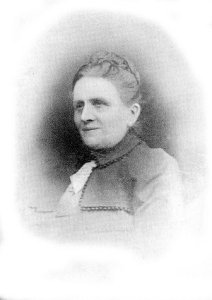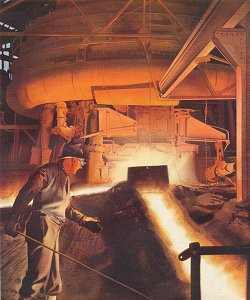|
|
|
|
The Hickman family bought
the Springvale Works in 1866. Iron may have been made on the
site since the 1780s or even earlier - and deeds relating to the
site, held in the Wolverhampton City Archives, go back to the 17th
century.
The Hickman’s not only made iron but they installed ball furnaces, puddling furnaces and mills to process the iron. The company also had a policy for securing their supplies and they bought up ironstone and limestone quarries, in Wales, Derbyshire and, most notably, at Corby. After long periods of boom and bust in the iron industry, there seems to have been what we would call rationalisation in the industry. In 1893 Lawley records that Sir Alfred Hickman was the only one of the ironmasters left in the trade in Bilston. |
Steel, and iron for turning into steel, usually came from Sweden, where there was not only iron ore of a high grade but also plentiful wood for charcoal and plentiful water power. This remained the case until the invention of the Gilchrist method of steel production. ( E. F. Soderlund, The Impact of the British Industrial Revolution on the Swedish Iron Industry, in L. S. Pressnell (ed), Studies in the Industrial Revolution, Althone Press, 1960).
| Both the Bessemer and
Siemen’s processes for producing steel required the use of
non-phosphoric iron ores. “The means of eliminating phosphorus was
discovered in 1875 by a scientific amateur, S. G. Thomas, and his
cousin, Percy Gilchrist. They introduced limestone in the
firebricks of the converter and in the charge, with which the
phosphorus combined to form basic slag. As the basic slag when
pulverised provided a valuable fertiliser, it is the more surprising
that Thomas’s invention was not an immediate success. … The
Gilchrist-Thomas process in effect doubled the potential steel
production of the world.” (Derry & Williams, pp.484-5). n 1882 Hickman set up the Staffordshire Steel and Ingot Iron Co. Ltd. “for the purpose of manufacturing in Staffordshire ingot, iron and steel by the Thomas Gilchrist process”. |
|
It was this Gilchrist-Thomas process which Hickman adopted and installed in Bilston, and which gave him the edge over other manufacturers and which turned Bilston from an iron town into a steel town. Hickman not only took up the method but also employed Gilchrist himself.
Lawley records this important development: “A recent addition to the great industrial enterprises of the township is that of the Steel Works, erected in 1883 for the manufacture of Bessemer and Siemen’s steel plates, bars, angles, tees, girders, etc.. These works have a capacity for turning out 400,000 ingots and 30,000 tons of finished steel plates and bars in a year. Sir Alfred Hickman, M.P., is Chairman of the Company.”
In 1883 Hickman bought all the equipment from the Mersey Iron and Steel Company, which had gone bankrupt and installed it at Bilston with modifications and improvements suggested by Percy C. Gilchrist, who was now on the board. These works were "the first of their kind that have been erected in Staffordshire with the object of making steel upon the Thomas Gilchrist (basic) method". (Report of the South Staffordshire Institute of Iron & Steel Works Managers, 1884).
The plant was a Bessemer Plant and an experimental open hearth furnace was built in 1887, which was used to de-siliconise the iron before it was transferred to the Bessemer furnaces. In 1896 a 15 inch bar mill was installed to add to the already installed 24 inch bar mill to process the iron rolled by the 34 inch cogging mill. There was also a small basic Siemens Furnace experimentally installed in 1906. The Bessemer Process continued until 1925 and in due course, when the Corby Works were built in 1934, Bilston men were transferred there to man the new Bessemer Plant.
|
|
In 1884 A. W. &. E. Hickman, sons of Alfred
Hickman, stated that "electricity is to be pressed into service to
render working by night as easy as by day".
Furthermore, "by a splendid mechanical device recently patented by Messrs. Gilchrist and Fitzmaurice (the Works Manager) … these convertors are about equal to six as worked at most other establishments and is as yet here exclusively in use". A water‑cooled stack was provided to replace the usual brickwork chimney back, which "while it is a source of safety, contributes most efficiently to the cooling of the platform … and is probably unknown at other English works". They were claiming to be innovative leaders in the industry. |




